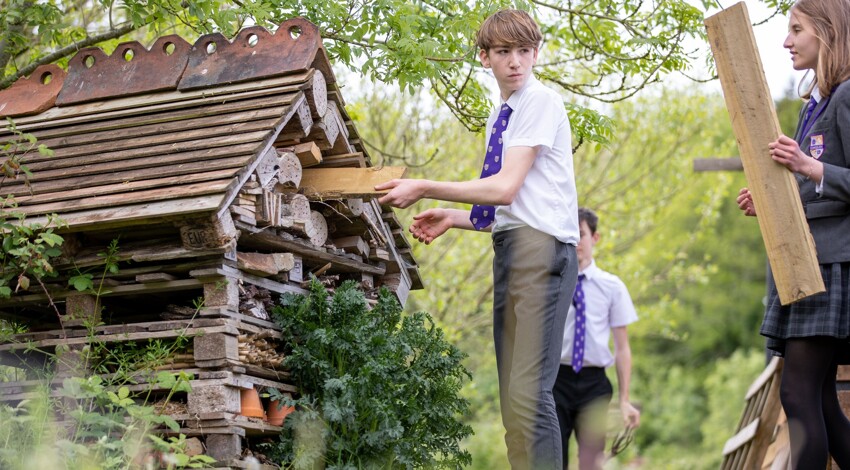
- Home
- Parents
- News
- This is planet Earth
This is planet Earth

Pubilshed by "Independent School Management", July 2024
https://independentschoolmanagement.co.uk/features/this-is-planet-earth/
Jack Harty, Devon Earth Centre manager at Kingsley School in Bideford, describes the drive towards sustainability at his school
Kingsley School is a co-ed independent day and boarding school in the heart of North Devon catering to around 450 children ranging from nursery ages to sixth form. Sitting in roughly 12 hectares of land and located within the UNESCO North Devon Biosphere and on the doorstep of the UK’s only world surfing reserve, the environment plays a significant role in everything that goes on in school.
This has been boosted by the founding of the ‘Earth Centre’ concept in 2019 where new school owners felt the school needed to double down on its unique setting and centre everything around sustainability and environmentalism to help pupils develop a deep understanding of the challenges, opportunities and solutions related to the world around them.
The concept percolates through school life and strategy ensuring that sustainability, environmentalism and ecology is embedded in everything that goes on in the school, from the curricula that are taught, to the way the grounds are managed, or how the estate is run. One core pillar of the strategy laid out in 2019 was the decarbonisation of the school estate with an aspiration for net-zero by 2027. Fast-forward to 2024 and a lot has changed, with great progress made in the past few years in several areas.
Now is the time
The way that we approached this was to conduct a full carbon footprint audit of the school. This was primarily to collect data for diagnosis of the site and secondly to act as a benchmark so that any improvements could be quantified to satisfy governors and owners of the progress made, and also to act as evidence that certain steps and improvements were financially beneficial, and that these decarbonising efforts deserve to be on the school strategy.
Our carbon footprint consists of three areas: scope 1 are the emissions from sources that a school owns or controls directly, scope 2 are emissions that a school causes indirectly and come from where the energy it purchases and uses is produced, and finally scope 3 are the emissions a school is indirectly responsible for up and down its supply chain. So, the reality is that to decarbonise a school campus, certain offsite activities also need to be thought about closely.
Scope 1
A step we have taken towards addressing our scope 1 values is the greater monitoring of our school-run minibus fleet. While electrification is on the agenda, at the moment financially this isn’t a step that can be taken. As a result, more careful monitoring of the school minibuses has been employed so that non-essential trips are reduced and an understanding of the impact our fleet has is better understood. Contributing roughly 10% of our 2021-22 carbon footprint at around 50 tonnes of carbon dioxide equivalent (tCO2e), percentage wise it doesn’t seem like much, but it is something that direct control can be taken over through policy and planning. Changes employed since have been the inclusion of carbon emission calculation within trip planning so that teachers wanting to use minibuses have to address directly the carbon associated with the transport manager, and that if this is deemed unnecessarily high, or if the transport isn’t being used efficiently, adjustments are suggested. The school-arranged bus routes have also been redesigned, reducing the number of smaller minibuses on the road in the morning and evening and replacing them with a larger, more efficient coach. These adjustments have seen a reduction last year by 4% in transport-associated tCO2e and an estimated additional 6% reduction this year with the recent introduction of the coach.
Due to being a boarding school, energy consumption on the site has a more continual output but of varying type. During the day energy peaks are due to electricity in the main school building (scope 2) and gas from the kitchens. In the evenings and weekends, consumption shifts to the boarding houses with electricity (scope 2) and gas for heating and hot water.
Within scope 1, the energy that is addressable is the volume of gas burnt, with historic pre-change volumes generating a CO2 equivalent of 258 tonnes. We have yet to look at the specific consumption data and quantify changes in the kitchens due to a new catering team taking over recently and their improvements/changing of practices being ongoing. But one improvement we have seen is with the installation of air-source heat pumps within some of the prep school classrooms and boarding facilities. This has reduced consumption of gas on site and while not substantial enough to create drastic change within our overall carbon footprint, it has been enough for future consideration for these units when replacement of outdated units arises. This has been supported during the boarding house refurbishments with the replacement of old glazing units, thus reducing the lost heat energy.
Scope 2
Our largest current progress in terms of our scope 2 has been through the transition to a ‘green energy tariff’ for our electricity. This was managed through our energy brokers, with the electricity being supplied to the school coming from renewable and green sources. The results of this were a reduction of 75 tCO2e of our carbon footprint associated with our electricity supply to zero. This obviously presents great potential for the impact it has on other elements of our carbon footprint, for instance, if all boilers could transition to air or ground source heat pumps, then the electricity associated with the running of those units would still generate nothing towards our carbon footprint, as would the full electrification of our minibus fleet, reducing the associated CO2 of our school-run transport to zero, both of which having profound impacts on Scope 1 measurements.
The next steps that we are taking towards our scope 2 comes in the form of the development and installation of a large onsite solar array. While initial surveys have taken place and sizes of systems specified to the school’s requirements, this forward momentum has slowed due to the return of investment changes in recent years when compared to the same outcome of zero tCO2e tariffs. Obviously, there are other considerations in terms of energy security and income from supplying excess energy back to the grid, but currently these are being outweighed by other factors. The added complication to our system is the location of it. Due to the sporadic nature of the school buildings and the most attractive location being that of the sports hall roof or a large bank near the sports hall, this presents certain issues with the energy’s consumption. Plainly the energy produced by a system needs to be consumed at the meter that the system is hooked up to, for us our consumption is not required at the sports hall but the main school building and boarding houses. To address this, meters would need to be removed and changed with new cabling laid – all of which contributes towards extra cost and complication, and ultimately the decision whether to move forward or not.
Scope 3
Scope 3 is a minefield for any business, but for a school with a varying and large supply chain it is a mountain to climb. It is in scope 3 that we are continuing to perfect our monitoring and measurement and may actually see an increase in our value over the coming years as we learn how to include more components of scope 3.
With support from a local energy consultant (361 Energy) using the financial data we have on our suppliers, we calculated the associated carbon footprint. The general rule of thumb recommended to us was that the top 10% of spend in a supply chain will probably constitute 90% of the associated supply chain emissions. With scope 3 there’s also a decision to be made as to when you are absorbing your suppliers’ carbon footprint; is it at the point of a product being created? or when it is shipped? or when it arrives at your door? There’s no hard and fast rule, so we elected to absorb scope 3 within our footprint at the point of creation of a product. As a result, our scope 3 in the 2021-22 academic year constituted 45% of our overall footprint at 262 tCO2e. Moving forward, policy is being brought into place surrounding the consideration of suppliers and establishing thresholds to ensure careful purchasing. But, as mentioned above, a supply chain in a school is a tough nut to crack, and we continue to work on it.
A component of scope 3 at the opposite end of the supply chain is the volume of waste produced. In steps to address this, our waste management was changed to Southwest Metals. This firm operates a ‘zero-to-landfill’ service so that now not only our recycled waste is repurposed, but our general waste is also sorted, recycled, reused, and avoids ending up in landfill. This supports the on-site composting that we already do for all our food waste produced, so that it is used on site in our ecology zone and market garden. The quantifying of these improvements in terms of the implications on the school’s carbon footprint is ongoing, with attention being turned to this in the current academic year as part of the curriculum.
We have addressed reduction in water wastage by working with Southwest Water. It completed a full water efficiency audit of the school site and fitted water saving devices and fixed any leaks around sinks, taps, showers etc. Estimated savings from motion sensing urinal cistermisers come in at 396,000 litres a year, lavatory cistern bags at around 328,000 litres, and aerators on taps and showers saving around 460,000 litres. All told, the savings that Southwest Water predicts based upon the devices installed come in at 1,184,000 litres, roughly half an Olympic-sized swimming pool. How this translates to decarbonisation is through the associated reduction of the wastewater processing; for this volume of savings the reduction of our carbon footprint is around 322 tCO2e per annum. We have also stopped using mop and bucket systems for our cleaning practices across the school site and are now using flat mopping systems that use up to 90% less water.
Another step being developed this year is beginning to tap into quantifying the commuting data of staff and pupils. This is currently being done by pupils during lesson time, but the provisional data being generated by them suggests that the associated CO2e of all of this is around 187 tonnes. This will obviously show an increase in our carbon footprint in comparison to previous years as this wasn’t calculated previously, but as mentioned above, that’s part of the journey we as a school are on in developing this in-house monitoring. In turn, this data will allow us to begin thinking about ways to improve the commutes of our community, with suggestions already being made of organised car-sharing, more buses, and the deployment of cycle to work schemes.
Sequestering carbon
Offsetting is a very important part of ensuring sustainability. However, Kingsley has chosen to address the problem of the emissions ourselves. We have used methods within the school grounds that sequester carbon, locking it in, but have not included these measurements of carbon sequestration within our overall carbon footprint calculations.
During the 2022-23 academic year, more than 1,500 trees were planted on the school campus, adding to the 3,500-plus planted over the previous four years over 2.5 hectares. This has continued into this academic year with trees being sourced for free from The Woodland Trust. These go some way in locking up CO2 with the estimated values of these newly planted trees locking in around 2 tCO2e per hectare per year, alongside our more established woodlands (5.5 hectares) which absorb around 10 tCO2e per hectare per year.
A larger component of the sequestration in our school grounds is our ecology zone consisting of nine ‘no-dig’ regenerative permaculture-focused beds. Not only does this provide nutrient-rich food for the pupils (with no food miles), but also supports carbon reduction. No-dig practices speed up carbon sequestration in the soil, locking down more carbon, faster. And with soil’s potential to hold carbon being more than biomass (vegetation) and the atmosphere combined, it makes great sense to us to look at supporting the growth of this store.
Our methods of measuring are constantly improving so variation is to be expected, as is the change in the number of factors and variables included within the overall value assigned to the carbon footprint. Clarity in this is important so that others know what our final figures represent and the meaning behind them.
For more information, The Independent Schools Council and Planet Mark published a research paper titled ‘Supporting Independent Schools on the Road to Net Zero & Sustainability’. The report delves into ways schools can enhance sustainability and transition to net zero. From data-driven strategies, to engaging students, the report highlights the pathway to a sustainable and cost-effective future for schools which we have found very useful for support but also as a benchmark for comparing our figures to other schools.

Jack Harty



